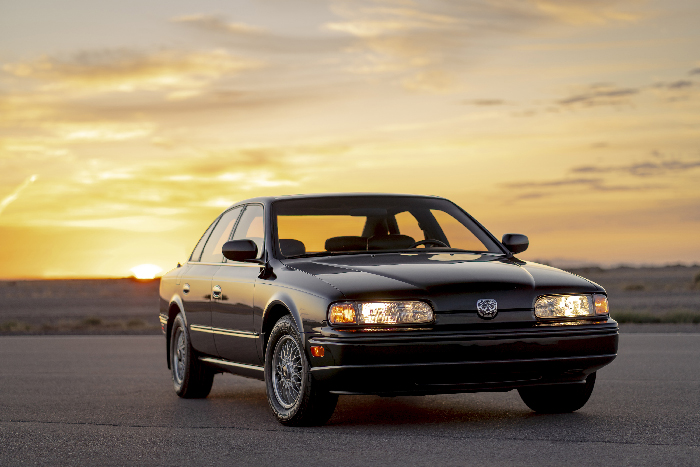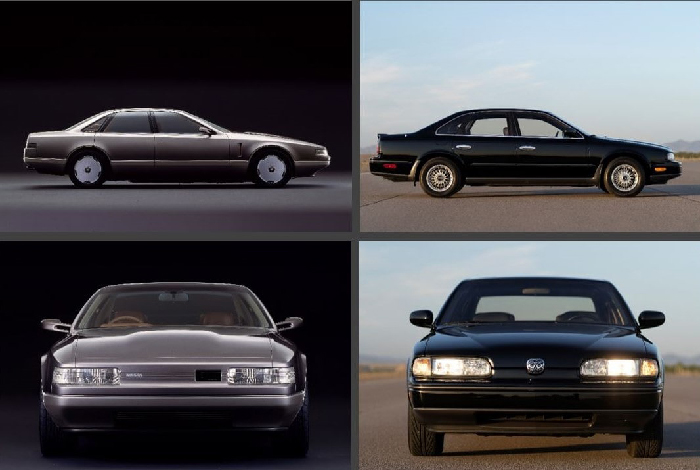In celebration of its 35th anniversary, INFINITI today commences a four-part series divulging lesser-known details on models from its early years.

The Q45, J30, FX and G Coupe helped put INFINITI on the map and Jun Shimizu, Alfonso Albaisa, Hideo Kumoro and Hiroyoshi Kato each played a role in either shaping the designs for these models, or finetuning the engaging experience they offered drivers.
Over the weeks ahead, we share their stories, peeling back the curtain on some of the lesser-known details regarding each model’s development.

The INFINITI Q45 – A statement maker to launch the brand
Jun Shimizu, former vice president of Nissan design, who oversaw both Nissan and INFINITI brands in the lead-up to INFINITI’s November 1989 launch, recounts details of its inaugural model, the INFINITI Q45.
CUE-X proceeds Q45
Shimizu confirms the conceptual direction for the INFINITI Q45 was established 4 years prior to its arrival, in the form of Nissan’s “CUE-X” Concept, which debuted at the 1985 Tokyo Motor Show.
Although at the time the concept was positioned as an exploration of Nissan’s “next-generation luxury high-performance sedan,” not an INFINITI, a side-by-side comparison of the “CUE-X” concept and subsequent production Q45, reveals more than coincidental similarities.
Exceeding the brief
The INFINITI Q45 was officially unveiled to world under the bright lights of the North American International Auto Show in Detroit in January 1989, and Shimizu credits the work of lead designer Shunji Yamanaka, who’s work exceeded the brief “to make something people had never seen before”.
Insights behind the grille
The flagship sedan featured distinctive yet minimalist styling, embodying a confident design, devoid of traditional cues including a radiator grille.
Speaking to this polarizing design element, Shimizu recalls the decision to omit a radiator grille, was not one that the Q45’s design team took lightly, noting the decision could have taken an entirely different route.
“The design team was essentially divided into two camps, one that favored a grille or badge and the other that wanted the fascia to be entirely clean”. Shimizu said, “I myself wanted quite a large badge on the front, so in some ways, the inclusion of the subtle emblem and no grille, was a kind of middle ground for us”.
Time honored art inspired inner badge motif
Even from a distance, the front badge that was selected to adorn the front of the Q45, draws the eye – not only as it is unique from almost anything available today, its considerably different to the logo that that adorns INFINITI’s current range.
Shimizu confirms that contrary to the belief of some, the initial INFINITI logo, which debuted within the Q45’s badge, was conceived in North America, with the surrounding floral motif crafted by the team in Japan.
The floral detailing was inspired by cloisonné-style art. More commonly associated with fine art and jewelry, than applied to anything in the automotive realm, cloisonné is a labor-intensive technique for decorating materials.
The use of cloisonné enamel, referred to as ‘Shippo-yaki’ dates back centuries in Japan and was a key inspiration for INFINITI design. In the case of the Q45 badge, it involved soldering ribbons of metal on their side, applying paint in the spaces between the wires and heating to finish. Three designs were considered, before the final motif was decided.
A driver’s car
The Q45’s distinctive minimalist exterior styling was paired with an interior that was equally devoid of traditional luxury cues from the era, such as wood inlays, instead, integrated technology delivered comfort and an elevated drive experience.
Shimizu recalls “The Q45 was quite large on the outside but the cabin wasn’t overly spacious, especially the second-row headroom – this was a conscious decision, as we opted to prioritize design over rear seat headroom, especially with the focus on this being a driver’s car”.
Big-ticket options in Japan
While buyers in the North America could access features such as a Bose sound system, power adjustable front seats with memory, one-touch power windows, digital climate control, and keyless entry system, many of these items paled in comparison to two big-ticket features available in the domestic Japanese market.
Buyers in Japan, where the vehicle was sold as a ‘Nissan INFINITI Q45’ priced from 5.2 million Japanese yen, could select two extravagant options –buyers seeking a truly unique interior, could opt for a lacquered trim panel set at a price of 430,000 Japanese yen. The set included the instrument surround, center console and door control panels, with each receiving an artisan’s touch. A layer of fine gold powder was sprinkled by hand with the surface finished with lacquer ensuring they were truly bespoke.
Additionally, an 18-karat gold key (priced at over 500,000 Japanese yen) was available as a dealer option.
Stay tuned, as we share more insights from behind the scenes of INFINITI’s early product range – next up, the sleek and daring INFINITI J30.


COMMENTS